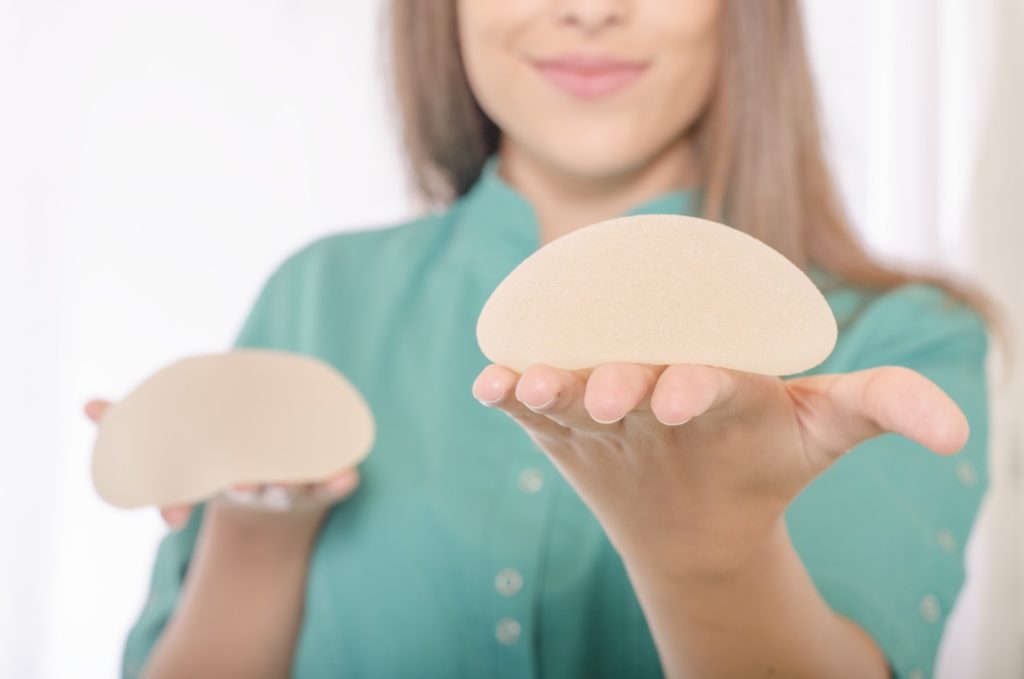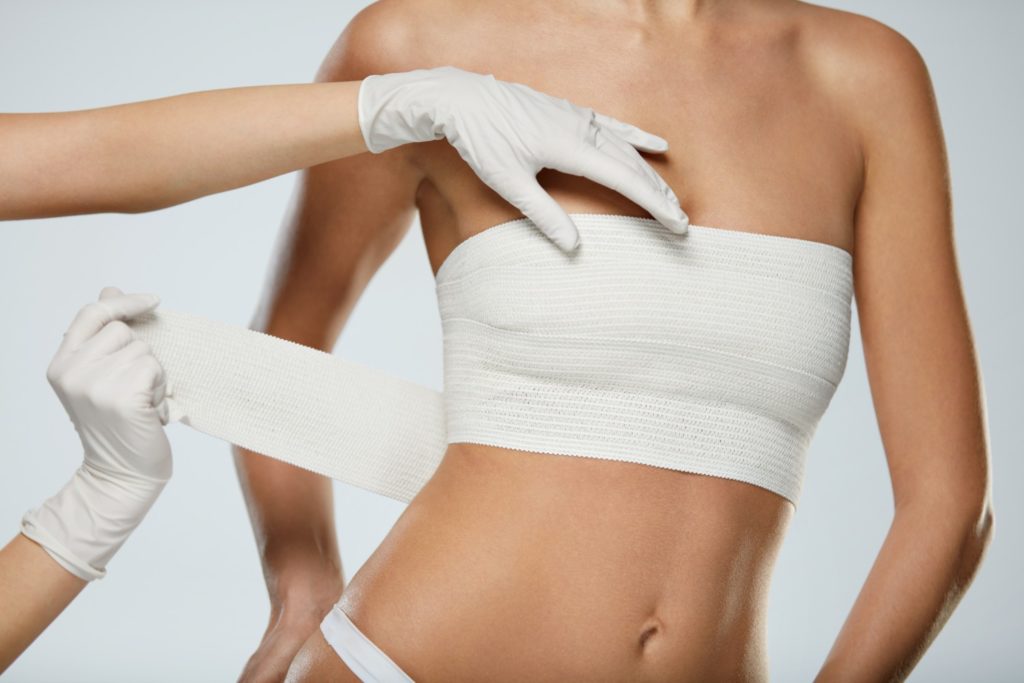In 2017, breast augmentation was once again the top cosmetic surgical procedure performed in America. This popular surgery is attractive to women for a number of reasons. Breast volume can be lost through pregnancy, breastfeeding, weight loss, or aging. Some women never develop very much breast tissue, to begin with. As a readily available procedure with an affordable price point, breast enlargement with implants can enhance the size and shape of women’s breasts to better blend with their body shape, and can also help to balance different sized breasts. If you are considering the benefits of breast augmentation, there are many, and depending on your particular needs and desired outcome, this procedure can:
- improve the size and shape of your breasts
- restore lost breast volume
- enhance the symmetry of your breasts
- help your breasts appear more proportionate to the rest of your figure
- rejuvenate the overall appearance of your breasts
For women who are looking into breast implants, the amount of information available online can be overwhelming. The Plastic Surgery Group of Memphis has put together this clear, concise guide to breast augmentation to help you make an informed choice that works best for you and your lifestyle.
Silicone or saline implants
There are two primary types of fillers used in breast implants: saline and silicone gel, which has been FDA approved. Saline implants have a silicone shell that is filled with sterile saline, or a salt water, liquid. Silicone gel implants have a silicone shell that is filled with a viscous silicone gel. Both implant types are very safe, and each has its own specific advantages.
Silicone implants provide a soft, natural feel to the breast, and for that reason, they are preferred by many patients. A silicone implant feels much closer to human breast tissue, and due to its cohesive nature, it will have far less “rippling” or wrinkling than a saline implant. For women with thin tissue, this is an especially important point to consider, as any irregularities in the contour of the implant will be obvious on the surface of the skin. Silicone gel implants arrive pre-filled from the manufacturer.
Saline filled implants are very safe for the body, and should one leak or rupture, the body will be able to safely reabsorb the solution. These ruptures are also easy to detect. Because they are filled at the time the surgery is performed, the volume is adjustable, which is an excellent option for women who have unequal breast sizes. This type of implant also may allow a smaller incision since it is not pre-filled.
The shape of breast implants
Shape is an important consideration when choosing breast implants. The two basic implant shapes are round and anatomic (teardrop). As every woman’s breasts will differ, the ideal implant shape must be determined with care by an experienced surgeon for the best results.
Round breast implants tend to be the most common shape used in breast augmentation. These implants come in many sizes, widths and projections. Round implants are easier for plastic surgeons to work with, and these implants can provide a good amount of lift, fullness, and cleavage. The symmetrical shape of a round implant means that the shape of the actual breast will not be compromised if the implant should happen to rotate. Even this round shape becomes teardrop shaped when upright which mimics the natural breast changes with position changes. An improperly sized implant can impact how natural an augmented breast looks, so it is important to work with a qualified plastic surgeon to determine the best size and shape implant for your body.
A teardrop breast implant may also sometimes be referred to as a contoured or anatomical breast implant, and are able to give a gently sloping contour that better resembles the natural shape of the breast. Though the contour and fullness of the upper breast tends to be better preserved with teardrop implants, they do require much more care when being inserted. For women who prefer a more naturally shaped breast, these implants can be the ideal choice. They are also an excellent option for women who have lost fullness or experienced stretching due to pregnancy and lactation.
Smooth or textured implants
Though many people are aware that there are different shapes and sizes when it comes to breast implants, you may not know that they can come in a smooth or textured surface. Smooth breast implants have a silicone shell with a smooth, polished surface. Textured implants are made of the same material, but the surface is irregular, almost like a soft version of sandpaper, with the texture formed right into the silicone shell. Depending on the manufacturer, this texture may be fine or coarse, but neither is rough.
An implant with a smooth surface is able to freely move and turn within the breast pocket, but an implant with a textured surface adheres to the breast pocket, keeping the implant anchored in position so that it cannot rotate. This is not a problem with a round implant, but if a teardrop implant is being used, rotation can actually result in an altered breast shape. While textured breast implants may be more likely to wrinkle or ripple, evidence suggests that patients with textured implants are less prone to capsular contracture. This is a breast augmentation complication that can develop if internal scar tissue forms a tight or constricting capsule around an implant, contracting it until it becomes misshapen and feels hard. Though studies are not conclusive, the textured surface has the potential to reduce the rate of capsular contracture, especially in subglandular augmentations.
The placement of breast implants
When it comes to placing breast implants, there are two options available: over the pectoral muscle (subglandular), or under the pectoral muscle (subpectoral.) Our experienced, talented plastic surgeons will choose the best method of inserting and positioning breast implants based on your anatomy.
The subglandular method consists of breast implants being placed under the breast tissue, just above the pectoralis muscle. Recovery time will typically be shorter, with less postoperative soreness, because the surgery does not alter the muscle. However, the breasts may appear less natural with a subglandular placement, because the transition from the chest to the breast is not quite as smooth. The appearance of rippling and folding may also be more visible because less tissue is covering the breast implant.
Submuscular placement of implants is often the preferred choice of both patients and surgeons because of the natural-looking results that can be achieved with this method. Breast implants are placed underneath the lower portion of the pectoralis muscle, which can help reduce the risk of rippling, particularly in patients who are petite, or those who do not possess much natural breast tissue. Like textured implants, there is some evidence that placing implants under the pectoral muscle can lessen the chance of capsular contracture. This method may require a longer recovery period. That said, many patients prefer how smooth the chest-to-breast transition and the ample implant coverage that is possible with submuscular placement.

Incision types
There are generally four locations where incisions can be made during breast augmentation. Your surgeon will decide on the right one for you during your consultation, after discussing your goals and desired outcome and assessing your body’s unique characteristics. These locations include:
Periareolar incision
Sometimes referred to as a breast augmentation nipple incision, this is made halfway around the lower circumference of the areola, allowing for a well-concealed scar as it remains hidden by the bumpy texture and darker pigment of the areola edge. If your primary concern is scarring, this is an excellent incision option. There have been some reports of this incision type affecting nipple sensation, capsular contracture and future breastfeeding, something your surgeon will discuss with your prior to your augmentation.
Inframammary incision
Placing an incision within the inframammary fold, the horizontal crease where the breast meets the body, is preferred by many plastic surgeons because it allows direct access to the tissue where the pocket is created making the surgery and implant placement more precise and accurate. Any size implant can be placed through this incision, and there is a lower risk of any breastfeeding difficulties or changes in nipple sensation, although the resulting scar may not be as hidden as with other incision types.
Transaxillary incision
Through this incision, a tunnel to the breast is created through the armpit using a lighted camera called an endoscope so that a pocket can be formed for implant insertion. There are no scars left on the breast itself, only in the armpit, but there is less control over what tissues are modified during surgery because the surgeon does not have direct visualization. Implant placement can be more difficult when it is done through the armpit, and recovery may be slightly more intense because of an increased risk of bleeding and bruising.
Transumbilical incision (TUBA)
The transumbilical incision is not very common and is not recommended by the surgeons of the Plastic Surgery Group.
Although there is no age that would be considered “best” for breast augmentation, you should be in good health overall and have no underlying medical conditions that could impede proper healing. It is also important to have relatively good skin elasticity in order to provide ample support for the implants. When you schedule a consultation with the Plastic Surgery Group of Memphis, one of our surgeons will assess your overall wellness and expectations, discuss your unique needs, and walk you through the results you can realistically expect to achieve through a breast augmentation procedure.

Our surgeons are dedicated to selecting the proper implants for you based on your body, lifestyle, and desired results. Our doctors will examine your skin quality, take chest measurements, assess the nipple position, and address any skin sagging, all of which will be used to create a customized plan for safely and effectively achieving a beautiful, natural-looking breast enhancement for you.
Following your breast augmentation surgery with Plastic Surgery Group of Memphis, you should expect some minimal to moderate swelling or bruising to be present temporarily, but these symptoms should resolve with time. Most discomfort will be mild, and many women will feel well enough to return to work, school, and their gentle daily routines after a week or so. The majority of swelling should subside within four to six weeks, at which point your breasts will be close to or at their final appearance.
If you are in Memphis or the Mid-South and are ready to explore the idea of breast augmentation, get in touch with us today to schedule your consultation!